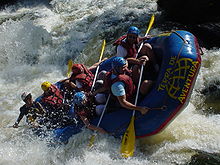Rafting



Rafting ( Engl. Raft , raft ') or rafting is popular in Central Europe since the mid-1980s has become recreational sport. In this water sport , a river is traveled with a rubber dinghy ( raft ) . Usually one goes on white water of higher difficulty levels . Rafting is operated as a recreational sport through commercial providers. Some canoeing clubs also offer rafting.
vehicles
Rafts are usually for two to twelve people. They consist of very robust, multi-layer rubberized fabric with several independent air chambers. The length usually varies between 3.60 m and 5.80 m, the width between 1.60 m and 2.50 m. A distinction must be made between different boat shapes. In Europe, the symmetrical raft steered with the paddle at the stern is the most common. Other types are the asymmetrical, rudder-controlled raft and the symmetrical raft with a central rudder system ( oars ' belt '). Rafts are moved forward with a paddle or oars. A special form, the inflatable kayak (ducky), is propelled forward with the double paddle and the two inflatable canoes again with the single paddle.
Competitive rafting sport
In rafting racing, since the founding of the International Rafting Federation (IRF) in 1997, official world championships in six-person rafts have been held every two years. From 2010 the four-person rafts followed in alternation with the six-person boats in even years, mainly on artificial whitewater systems to prepare the way to the Olympic Games ( Olympic Class ). The disciplines of time trial (1–3 minutes), parallel sprint head to head (1–3 minutes), slalom (with up to 14 goals; 3–4 minutes) and downhill (20–60 minutes) are driven according to the rules of the IRF. There are European Championship and World Championship titles for each individual discipline, as well as for the overall ranking.
safety
Rafting has become a relatively safe leisure activity thanks to the now quite sophisticated safety measures of the predominantly commercial providers. Depending on the target area, there are sometimes quite rigid safety measures from public institutions for the providers: This ranges from the obligation to inspect entrepreneurs and boat drivers to regular inspection of the boats to clear regulations regarding the equipment to be carried. If the usual safety rules are observed, rafting is not a particularly dangerous sport.
Relationship between rafting and nature conservation and other users
Like all nature sports, rafting is in conflict between nature conservation and nature use. Rafting does not usually destroy a river landscape, as the entrances and exits are usually determined by the authorities and accordingly the embankments are only slightly polluted.
Rafting as an economic factor in many alpine regions contributes to the fact that the further construction of rivers for energy generation does not occur and the rivers remain as a habitat for fish and for canoeing. In the meantime, these natural landscapes are endangered , especially in Tyrol, by current power plant projects on the Inn, Sanna and Ötztaler Ache.
In the past there have been problems between anglers and rafters, but these have largely been resolved by compromise solutions such as restrictions on annual and daily sailing times.
Canoeists and rafting operators have largely similar interests. Canoeists benefit from the infrastructure of commercial rafting, such as entry and exit points. A raft is a considerable danger for a canoe due to its size. On the descent, rafters often encounter white water canoes playing on a wave. The kayak has to dodge as the raft is sluggish and has the right of way because it comes from above. Most of the raft guides (boat drivers) are active white water paddlers themselves. You know both sides and behave considerately.
Canoeists as well as rafting providers and nature conservation associations advocate the removal of dangerous, superfluous artificial river barriers (e.g. box weirs, old dams and bridge piers) in order to make the rivers passable again for fish and boats and to increase the safety for canoeists and rafters. However, some canoeists complain that rafting operators, in cooperation with municipalities and tourism associations, are doing dredging and blasting work in natural river beds in order to eliminate safety risks in the river. In fact, these measures usually only last for a short time, as a river bed is subject to permanent changes and interventions are often undone again with the next major flood.
See also
literature
- Christoph Erber: Rafting. Conrad Stein Verlag, 2008.
Web links
- Link catalog on rafting at curlie.org (formerly DMOZ )
- International Rafting Federation website
Individual evidence
- ^ Teva World Rafting Championships 2010 , Canoe Magazine, August 5, 2010.
- ↑ Stubai water
- ↑ Sannafest 2014 .
- ↑ Authorization for rafting trips - a heavy blow for fishing , nature and land , magazine of the Austrian Nature Conservation Union, 1991 (PDF; 2.01 MB).
- ↑ Nature wins over concrete , American Whitewater, Christoph Scheuermann, Kanumagazin, February 20, 2012.



